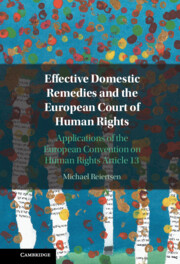 Effective Domestic Remedies and the European Court of Human Rights
Effective Domestic Remedies and the European Court of Human Rights Published online by Cambridge University Press: 11 August 2022
Chapter 4 first analyzes how Article 13 was dealt with during the drafting of the Convention. A central conclusion is that the drafting does not explain the Court’s timid development of Article 13 in early years and that it, rather, may provide support for a further development of Article 13 in the present. The chapter then describes how the number of cases concerning Article 13 has increased in tandem with the general rise in the Court’s case law and how, in more recent years, the Court actually considers whether Article 13 has been violated, in addition to substantive Articles. However, the Court rarely explains why this is necessary. This makes it difficult to distinguish between similar remedial requirements arising under both Article 13 and substantive Articles. However, as the chapter explains, this could be necessary in order to underline specific remedial purposes and to avoid undercommunicating remedial goals, most notably achieving sufficient redress, but, also, procederual requirements necessary in order to ahcieve redress. The chapter, also, provides a more detailed overview of how Article 13 has been dealt with in conjunction with substantive Articles.
To save this book to your Kindle, first ensure [email protected] is added to your Approved Personal Document E-mail List under your Personal Document Settings on the Manage Your Content and Devices page of your Amazon account. Then enter the ‘name’ part of your Kindle email address below. Find out more about saving to your Kindle.
Note you can select to save to either the @free.kindle.com or @kindle.com variations. ‘@free.kindle.com’ emails are free but can only be saved to your device when it is connected to wi-fi. ‘@kindle.com’ emails can be delivered even when you are not connected to wi-fi, but note that service fees apply.
Find out more about the Kindle Personal Document Service.
To save content items to your account, please confirm that you agree to abide by our usage policies. If this is the first time you use this feature, you will be asked to authorise Cambridge Core to connect with your account. Find out more about saving content to Dropbox.
To save content items to your account, please confirm that you agree to abide by our usage policies. If this is the first time you use this feature, you will be asked to authorise Cambridge Core to connect with your account. Find out more about saving content to Google Drive.